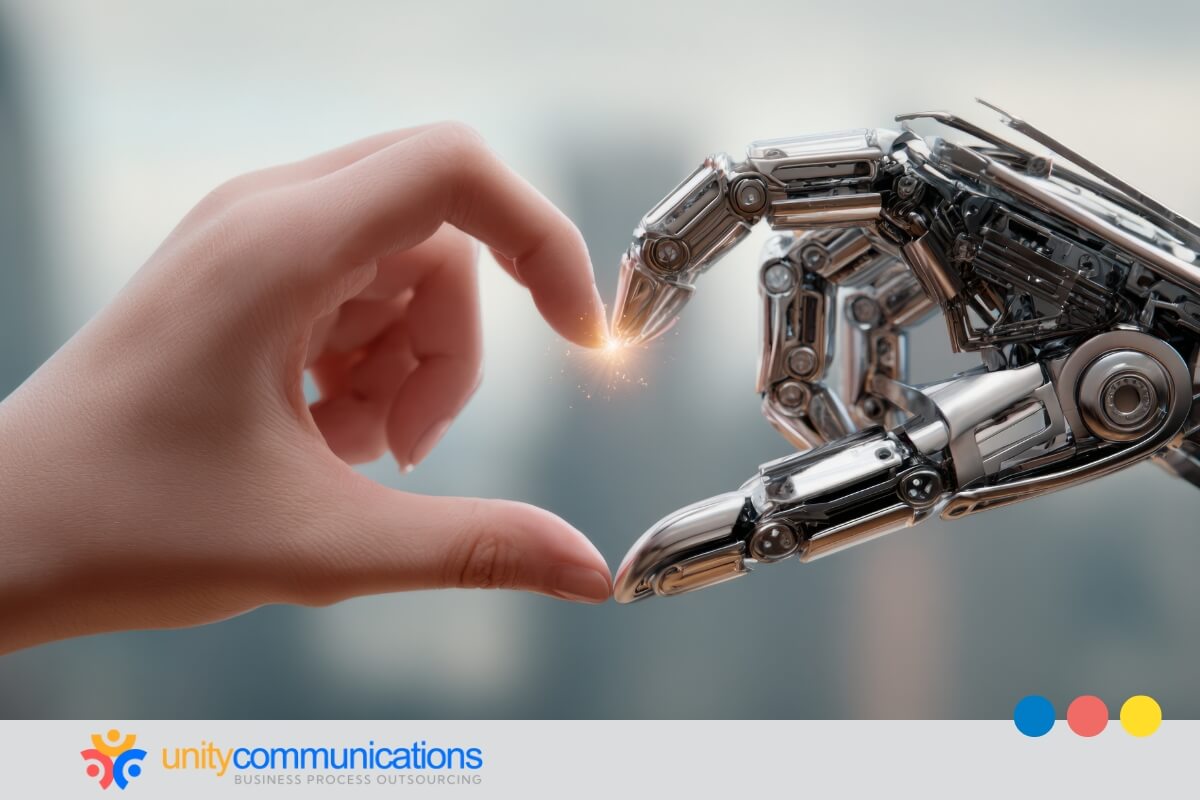Table of Contents
Artificial intelligence (AI) is reshaping how businesses operate, with intelligent systems shaping everything from customer support to compliance oversight. At the center of this shift are AI agents and intelligent agents, each with different strengths in autonomy, adaptability, and performance.
Business process outsourcing (BPO) gives small and medium-sized businesses (SMBs) access to these technologies without heavy upfront costs, making the choice between them even more critical.
This comprehensive guide compares AI agents vs. intelligent agents, providing practical insights into their capabilities, use cases, and strategic implications.
Understanding these distinctions is essential for making informed technology decisions that align with your business objectives and operational requirements.
AI agents vs. intelligent agents: Core definitions explained

When you hear about AI and intelligent agents, the terms seem interchangeable, but their meanings differ. AI agents focus on task execution through machine learning (ML), automation, and adaptive decision-making models.
Intelligent agents, by contrast, rely on predefined rules and limited responses within structured environments. Industry research highlights their growing importance.
Analysts estimate the global AI agents market reached $5.25 billion in 2024 and could surpass $52 billion by 2030, underscoring widespread adoption across industries. This explosive growth reflects the increasing recognition that organizations require more sophisticated automation solutions to remain competitive.
Understanding these differences is critical for choosing the right solution for your business operations. Their capabilities become clearer when you examine core functions:
- AI agents learn from data, refine outputs, and respond flexibly to dynamic conditions.
- Intelligent agents operate on fixed instructions, often without adaptability or contextual memory.
The debate on AI agents vs. intelligent agents’ capabilities also connects directly to business strategy. Smaller firms already use AI-driven systems to automate support functions, improve task accuracy, and expand productivity in ways once limited to larger enterprises with bigger budgets.
This is where BPO for small businesses becomes practical. Many outsourcing firms integrate AI agents into service packages, benefiting you from advanced tools without heavy upfront investment.
Accessing these definitions provides the clarity needed to move into more profound autonomy, adaptability, and scalability differences.
Which model works best for SMBs: AI agents or intelligent agents?
Knowing the distinctions between AI and intelligent agents helps you choose the right solution for your business. By early 2025, about 63% of mid-sized companies (up to 2,000 employees) had AI agents in production across tech and non-tech firms.
This highlights how widespread AI deployment has become and why understanding the differences matters.
This guide compares AI agents vs. intelligent agents across 10 areas: autonomy, adaptability, decision-making, system architecture, deployment, intelligence, interaction, data handling, performance, and governance.
Each criterion highlights practical applications and operational advantages that inform your decisions:
1. Autonomy and level of independence
Understanding autonomy is critical when evaluating AI agents for your business. AI agents vs. intelligent agent systems differ significantly in how independently they can operate, complete tasks, and manage workflows.
Recognizing this distinction helps you plan resource allocation and prioritize which processes to automate first.
AI agents are designed for high autonomy. They perform tasks with minimal supervision, adapt to changing inputs, and operate in dynamic environments without constant oversight. This independence lets you handle routine or complex tasks without overloading your team and reduces the need for continuous monitoring, freeing your staff to focus on strategic initiatives.
Intelligent agents operate under fixed, pre-programmed rules. Their actions are limited to defined scenarios and require human input whenever exceptions occur or conditions change. They perform well in structured settings but lack the flexibility to self-adjust or respond to unexpected developments, slowing operations in fast-moving business environments.
Compare their autonomy below:
| Feature | AI agents | Intelligent agents |
|---|---|---|
| Autonomy level | High | Low |
| Human intervention | Minimal | Frequent |
| Operational scope | Flexible across environments | Limited to set scenarios |
| Supervision needed | Low | High |
| SMB suitability | High | Moderate |
Recognizing these differences for SMBs helps determine which agent type aligns with operational goals and resource availability. Autonomy remains the first key factor in guiding adoption strategies.
2. Adaptability and learning capability
Grasping adaptability is essential when evaluating AI agents for your business. AI agents vs. intelligent agent systems differ in their ability to learn from data, adjust to changing inputs, anticipate emerging patterns, and improve over time. Recognizing these differences helps you identify which workflows benefit most from automation.
AI agents continuously refine outputs based on new information. They adapt to evolving business conditions and handle complex tasks without constant supervision. Industry reports project that AI agents could deliver as much as $450 billion in value by 2028. This emphasizes how adaptable AI systems can drive significant financial impact across industries.
Intelligent agents rely on fixed rules. They follow predefined instructions and cannot learn independently, limiting their effectiveness in dynamic environments. You can still use them for repetitive, predictable tasks. However, exceptions or changes require frequent human intervention.
Adopting AI agents supports operational efficiency, faster response times, and enhanced decision-making for SMBs. These benefits improve competitiveness and free your team to focus on higher-value initiatives, while intelligent agents offer structured support for simpler processes.
Here’s how AI agents vs. intelligent agent systems fare in adaptability and learning capability:
| Feature | AI agents | Intelligent agents |
|---|---|---|
| Learning capability | High | Low |
| Adaptation to change | Continuous and dynamic | Static and rule-based |
| Human oversight required | Minimal | Frequent |
| Suitability for SMBs | High | Moderate |
Understanding adaptability helps you leverage AI agents effectively. It guides smarter deployment and maximizes operational gains.
3. Decision-making scope and flexibility
Decision-making scope defines what an agent can decide, while flexibility describes how it adapts when conditions shift and new variables emerge. In comparing AI agents vs. intelligent agent systems, you should understand these boundaries to delegate tasks safely without losing efficiency, accuracy, or control in daily operations.
AI agents manage broad decision spaces using goals, policies, and adaptive feedback loops. They weigh signals, select tools, and adjust actions in near real time. This translates into quicker approvals, more intelligent routing, and fewer bottlenecks across pricing adjustments, incident triage, demand forecasting, and customer support workflows.
Conversely, intelligent agents operate within narrow scopes defined by static rules and business playbooks. When inputs move beyond their boundaries, they escalate to human oversight or halt execution. This design maintains compliance and predictability but often limits responsiveness, especially when external conditions or customer expectations rapidly change.
Below further explains their decision-making capabilities:
| Feature | AI agents | Intelligent agents |
|---|---|---|
| Decision scope | Broad, goal-oriented | Narrow, rule-bound |
| Flexibility | High under shifting context | Low outside templates |
| Human escalation | Occasionally, for edge cases | Frequent, for exceptions |
| Typical fit | Dynamic operations and pricing | Stable, regulated workflows |
Recognizing how decision-making scope and flexibility differ enables smarter adoption. AI agents empower greater autonomy and agility, while intelligent agents support stability and compliance.
Aligning the right system with your workflows boosts performance, reduces risk, and ensures technology decisions effectively serve operational speed and strategic priorities.
4. Technology stacks and system architecture
Technology stack choices determine how your agents run, scale, and connect to data sources. In practical terms, they shape development speed, operating costs, and integration work. When weighing options in AI agents vs. intelligent agents comparisons, focus on what your team can manage and what your systems must support.
Modern stacks combine model hosting, orchestration, vector memory, application programming interfaces (API) connectors, and observability. They can integrate with robotic process automation (RPA) to hand off repetitive work. Components include:
- Model hosting
- Orchestrator and workflow engine
- Long-term digital memory and connectors for scaling for production readiness overall
Intelligent deployments favor leaner stacks with a rule engine, deterministic flows, and direct system hooks. These architectures reduce infrastructure needs and simplify audits.
In contrast, full AI stacks require model serving, monitoring, and retraining pipelines. This raises operational overhead but yields richer capabilities in complex contexts.
Here’s how AI agents vs. intelligent agent systems compare in technology stack and system architecture:
| Feature | AI agents | Intelligent agents |
|---|---|---|
| Model | Large models, hosted inference | Rule engines, scripted logic |
| Orchestration | Orchestrator, workflow use | Scheduler, basic flows |
| Memory | Vector store, long-term memory | Short state |
| Integrations | APIs, connectors, observability | Direct secure hooks |
Matching stacks to needs limits wasted spending and speeds deployments. Choose simpler architectures for stable, regulated tasks and richer AI stacks where flexibility and advanced integrations add measurable value to your operations.
5. Deployment and scalability approaches in practice
Deployment and scalability determine whether an agent serves a handful of users or entire operations. When you assess AI agents vs. intelligent agent options, weigh how each affects rollout speed, operational risk, and the resources required to keep services stable and responsive
Cloud native deployments offer rapid scale and pay-as-you-go pricing. On-premises installations give stronger data control and compliance advantages. Hybrid models let you balance cost, latency, and regulatory constraints. Supporting practices include:
- Containerization and orchestration for consistent deployments
- Autoscaling rules and resource quotas to match real demand
- Multi-region redundancy for uptime and disaster resilience
- Staged rollouts, canary releases, and rollback plans for safer updates
These approaches highlight how architecture influences long-term stability and agility. High-growth firms favor elastic cloud setups, while regulated sectors choose controlled rollouts. The decision rests on risk tolerance, compliance demands, and your capacity to manage overhead.
Here’s how each stacks up for deployment and scalability:
| Feature | AI agents | Intelligent agents |
|---|---|---|
| Deployment model | Cloud native, containerized, elastic | On-prem or scheduled deployments |
| Scalability | Horizontal autoscaling and load balancing | Vertical scaling, quotas, and manual provisioning |
| Rollout pattern | Canary and blue-green releases | Phased manual releases |
| Operational burden | Needs model monitoring and retraining pipelines | Lower overhead, simpler operations |
Match deployment style to your tolerance for operational work and your growth plans. Picking the right scalability approach helps you expand reliably while controlling costs, latency, and risk.
6. Intelligence models: Machine learning vs. rule-based logic
You must understand the underlying intelligence model to choose wisely. While exact data is limited, overarching trends show enterprise AI deployments in 2025 are shifting toward learning-based “agentic” architectures, which now account for more than 60% of cases.
This trend moves your organization from fixed rules to systems that learn from data and context. When applied in real scenarios, their contrasts stand out clearly:
- Learning models detect patterns and adapt across scenarios, reducing manual rule updates.
- Rule-based logic provides clarity and predictable behavior for fixed workflows.
- Learning systems need active monitoring and retraining, while rule-based ones require manual maintenance.
Choosing between AI agents and intelligent agents affects service provider choice, testing complexity, and how your team supports the system long term. Learning-based agents can unlock broader customer engagement or operations capabilities, while rule systems support compliance and simplicity.
Learn more about their differences in intelligence foundations below:
| Feature | AI agents | Intelligent agents |
|---|---|---|
| Intelligence | Learning models, probabilistic inference | Rule engines, scripted logic |
| Adaptability | High—Learns and improves over time | Low—Static unless manually updated |
| Maintenance | Model monitoring and retraining are needed | Manual rule edits and testing |
| Deployment fit | Dynamic tasks and evolving goals | Fixed workflows and audit needs |
Where you draw the line depends on your tolerance for complexity, desire for flexibility, and resource availability. You set your team up for smarter, more resilient adoption by aligning decisions to your goals.
7. Interaction models with humans and systems
How your agents interact with people and existing tools shapes day-to-day usability. You want systems that fit smoothly into workflows, reduce friction, and give your team clarity when making decisions.
Interaction models differ in exchanging feedback, triggering actions, and managing contexts. In practice, these differences are critical but straightforward:
- AI-driven agents can automatically hold contextual conversations, interpret intent, and link outputs to business systems.
- Rule-based agents respond with predictable instructions, often requiring manual confirmation or re-entry.
Both approaches influence how your staff collaborates with technology and how quickly it resolves issues. Comparing AI agents vs. intelligent agent capabilities reveals a broad spectrum of human-system interaction.
AI models tend toward natural dialogue and adaptive integration, while rule-based models emphasize structure and repeatability. These can affect your team’s customer experience, internal adoption speed, workflow efficiency, and training requirements.
Here’s a feature comparison for quick reference and insight:
| Feature | AI agents | Intelligent agents |
|---|---|---|
| Communication style | Conversational, context-aware responses | Menu-driven or step-based prompts |
| Integration with systems | API-driven links to multiple platforms | Direct connections with limited scope |
| User experience | Adaptive, responsive, intuitive | Consistent, predictable, rigid |
| Collaboration level | Supports multi-turn dialogues | Single-turn or sequential steps |
How you interact with technology guides how much control remains with people and how much shifts toward automated assistance. These models set expectations for both employee workflows and customer engagement.
8. Data handling, context retention, and memory
How agents process information, recall prior exchanges, and carry context into new interactions defines their usefulness in daily operations.
The gap between short- and long-term context affects accuracy, decisions, and customer experience. This makes memory one of the most practical considerations when weighing adoption choices.
The holistic context-aware system test (HCAST) benchmark shows that leading AI agents succeed 70–80% of the time on tasks that take humans under an hour, but under 20% succeed on more complex four-hour tasks.
This shows memory limits, so today’s systems still need oversight on high-stakes or extended tasks. In real scenarios, you can expect contrasts such as:
- AI-driven agents store conversations for continuity and better personalization.
- Rule-based agents start each session fresh without reference to prior inputs.
- AI memory enables predictive actions, while rule-based memory provides static output consistency.
Comparing AI agents vs. intelligent agent performance in memory reveals where adaptability outweighs predictability and when simplicity is the safer route. See this feature comparison for a clear overview:
| Feature | AI agents | Intelligent agents |
|---|---|---|
| Data handling | Learns from patterns and feedback loops | Processes inputs in isolation |
| Context retention | Carries context across multiple interactions | Limited to the current session only |
| Memory use | Dynamic, adaptive, predictive | Static, rule-bound, consistent |
| Practical fit | Customer service, operations, and personalization | Auditing, compliance, repeatable tasks |
How agents handle memory shapes reliability, user trust, and how far you can extend automation across your workflows.
9. Performance metrics and optimization methods
Performance is not just about whether a system runs but how effectively it contributes to your goals. You want to measure where time is saved, how accuracy holds up, and what return the business gets.
Industry research shows measurable gains. AI agent deployments report time savings such as 12–30% in customer service, 30–90% in internal operations, and 9–21% increased revenue in sales and marketing.
This means you can quantify improvements and use metrics to steer optimization efforts. When looking at performance, you should focus on metrics that matter to operations, such as:
- Time saved per task or workflow
- Accuracy and error reduction in decision-making
- Customer satisfaction scores after interactions
- Revenue uplift from improved targeting and engagement
Optimization depends on system type. AI agents need monitoring and retraining, while intelligent agents depend on rule and workflow audits.
Each method reflects the intelligence model it supports. Here is a feature comparison showing how AI agents vs. intelligent agents differ in performance metrics and optimization methods:
| Feature | AI agents | Intelligent agents |
|---|---|---|
| Measurement focus | Dynamic benchmarks, adaptive key performance indicators (KPIs) | Fixed rules, compliance metrics |
| Optimization method | Retraining models, adjusting parameters | Updating rules, manual testing |
| Speed of improvement | Fast with new data inputs | Slower, depends on human edits |
| Business impact | Expansive efficiency and growth | Predictable and stable outputs |
Performance metrics connect strategy with measurable outcomes, guiding which system delivers greater value for your team.
10. Ethical, compliance, and governance safeguards
Ethical, compliance, and governance practices define your systems’ safety and trustworthiness in daily operations. You need technologies that protect standards and minimize risks, especially as agents take on greater responsibility.
Studies report risks such as 39% unauthorized access, 33% inappropriate sharing, and 23% credential leaks. This shows that even advanced tools can introduce serious vulnerabilities without proper oversight.
You need clear accountability structures, transparent decision logs, and safeguards that prevent misuse. In practice, you should focus on:
- Audit trails that track decisions and actions
- Access controls that limit sensitive data exposure
- Bias checks to avoid unfair or inconsistent outputs
- Compliance alignment with industry regulations and standards
- Incident response protocols for rapid issue resolution
AI-driven systems introduce complexity that requires ongoing ethical review, while rule-based agents operate with simpler but more rigid governance structures.
Both approaches can fit into your business, but the level of oversight differs by design. Here is a comparison of governance practices in AI agents vs. intelligent agents:
| Feature | AI agents | Intelligent agents |
|---|---|---|
| Risk exposure | Higher, due to adaptive decision-making | Lower, limited to predefined rules |
| Oversight needed | Continuous monitoring and audits | Periodic rule and workflow checks |
| Transparency | Probabilistic and harder to interpret | Clear, predictable logic |
| Compliance fit | Stronger for dynamic environments | Stronger for regulated, fixed workflows |
Strong governance connects ethics, compliance, and trust, helping your business adopt technology responsibly.
Outsourcing strategies for adopting and scaling AI agents

What is BPO, and how can it support your adoption of AI agents at scale? Outsourcing provides structured pathways to access talent, resources, and infrastructure that many organizations might not have in-house.
AI and BPO partnerships combine automation expertise with flexible delivery models, helping you achieve growth without overextending internal teams.
The opportunities and challenges of integrating AI in outsourcing involve balancing innovation with operational discipline, particularly when governance and compliance are at stake.
Comparing AI agents vs. intelligent agents reveals different outsourcing needs, guiding smarter choices for investment and management.
1. Specialized expertise through BPO partnerships
Outsourcing firms provide access to specialized expertise for adopting and managing AI-driven systems. They bridge capability gaps when building advanced in-house teams is costly or slow.
Outsourcing works because BPO providers offer technical depth across industries. Their knowledge covers integration, training, and maintenance, supporting smooth operations without burdening internal staff.
With AI in call centers, outsourcing adds expertise in speech, sentiment, and conversation design to scale support.
Key benefits include:
- Access to rare skill sets
- Faster adoption and deployment
- Scalable service models tailored to business growth
Specialized outsourcing expertise helps you advance confidently with AI systems.
2. Cost-efficient models for faster time-to-market
Adopting AI-driven systems, speed matters. Outsourcing supports faster deployment with flexible, cost-conscious models. Instead of building complex structures internally, you can tap into proven delivery frameworks that balance efficiency with operational stability.
BPO pricing models give you choices that align with budget and growth plans. Whether fixed-fee, outcome-based, or pay-per-use, these structures keep costs predictable while accelerating delivery.
BPO advantages extend beyond cost savings, offering quick scaling and specialized knowledge that shortens time-to-market.
Key highlights include:
- Reduced upfront investments
- Flexible contract terms
- Faster ramp-up cycles
Outsourcing-driven models help you accelerate adoption effectively.
3. Customized balance of control and vendor reliance
When comparing AI agents with intelligent agents, decision-makers typically weigh control against dependence on external partners. This choice shapes adoption strategies, particularly in outsourcing vs. offshoring discussions, where governance and vendor oversight become crucial.
Striking the right balance depends on your operational priorities:
- AI agents allow tighter configuration within enterprise systems.
- Intelligent agents often depend on vendor platforms for advanced functions.
- BPO vendor reliance introduces efficiency but requires monitoring to align with standards.
The balance between independence and service provider reliance defines how your organization integrates intelligent systems while protecting agility and operational stability.
4. Compliant practices for risk and data security management
Risk and compliance stand at the core when comparing AI and intelligent agents. Both need strong safeguards, yet their approaches to protecting sensitive data can differ, especially when external service providers are involved.
Security measures usually include:
- Encryption protocols for data in motion and at rest
- Role-based access controls to protect sensitive information
- Continuous monitoring to flag suspicious activity
- Vendor audits for compliance assurance
For many SMBs, outsourcing introduces BPO risks and drawbacks, including data handling across jurisdictions and vendor accountability gaps. Addressing these factors early helps strengthen adoption while preserving trust across regulatory and operational environments.
The bottom line

Choosing between AI and intelligent agents is a strategic choice that will define your operational capabilities and competitive positioning for years to come. The distinction between autonomous, adaptive AI agents and rule-based intelligent agents directly affects everything, from cost efficiency to scalability potential.
Evaluate which approach aligns with your operational requirements and growth objectives. Develop a phased approach that balances innovation with operational stability.
Outsourcing adds strategic value by providing expertise and scalability while ensuring operational discipline. With BPO partnerships, you gain advanced capabilities without overstretching your internal teams, safeguarding compliance and stability.
Ready to transform your operations with the right AI strategy? Let’s connect today.




